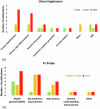Advancing breast, lung and prostate cancer research with federated learning. A systematic review
- PMID: 40425787
- PMCID: PMC12117161
- DOI: 10.1038/s41746-025-01591-5
Advancing breast, lung and prostate cancer research with federated learning. A systematic review
Abstract
Federated learning (FL) is advancing cancer research by enabling privacy-preserving collaborative training of machine learning (ML) models on diverse, multi-centre data. This systematic review synthesises current knowledge on state-of-the-art FL in oncology, focusing on breast, lung, and prostate cancer. Unlike previous surveys, we critically evaluate FL's real-world implementation and impact, demonstrating its effectiveness in enhancing ML generalisability and performance in clinical settings. Our analysis reveals that FL outperformed centralised ML in 15 out of 25 studies, spanning diverse models and clinical applications, including multi-modal integration for precision medicine. Despite challenges identified in reproducibility and standardisation, FL demonstrates substantial potential for advancing cancer research. We propose future research focus on addressing these limitations and investigating advanced FL methods to fully harness data diversity and realise the transformative power of cutting-edge FL in cancer care.
© 2025. The Author(s).
Conflict of interest statement
Competing interests: G.P., S.B. and H.K. are full-time employees of Pfizer and hold stock/stock options. C.B. is a full-time employee of Flower. P.L. has/had minority shares in the companies Radiomics SA, Convert Pharmaceuticals SA, Comunicare SA, LivingMed Biotech srl and Bactam srl. The other authors do not have any financial or non-financial competing interests to declare.
Figures





References
-
- Painuli, D. & Bhardwaj, S. Recent advancement in cancer diagnosis using machine learning and deep learning techniques: A comprehensive review. Comput. Biol. Med.146, 105580 (2022). - PubMed
LinkOut - more resources
Full Text Sources

